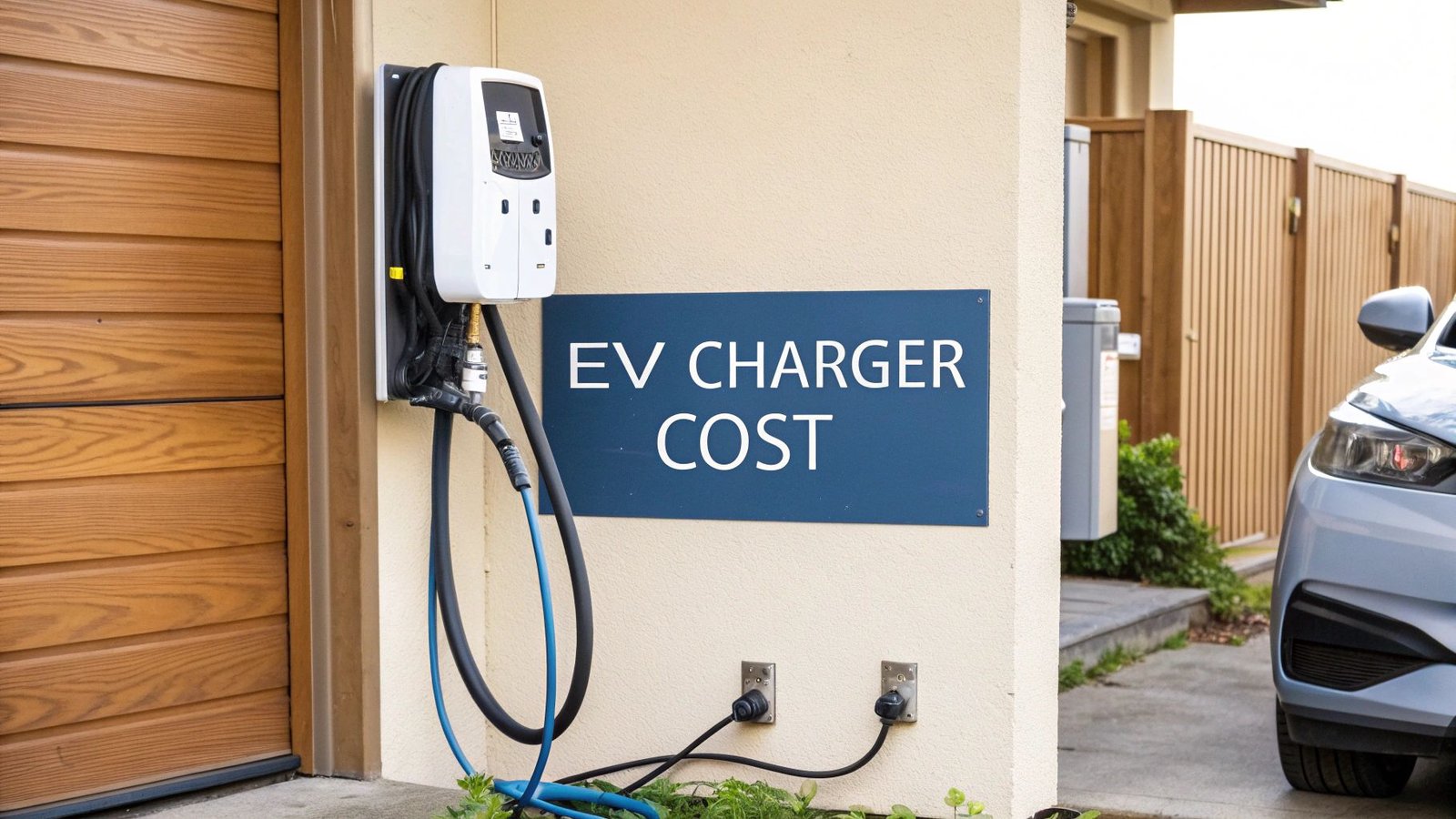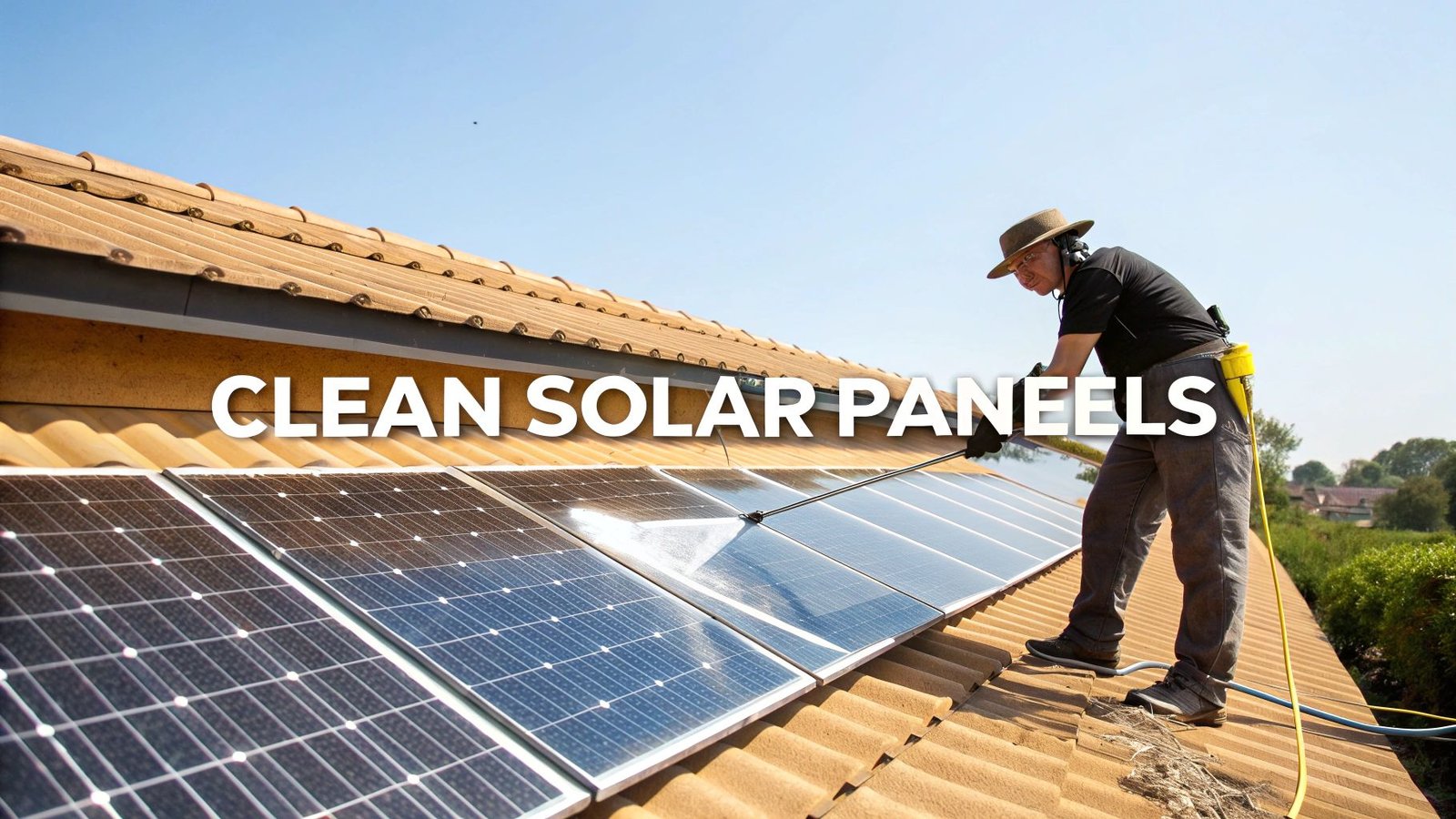So, what's the real cost to get a home EV charger set up? For most people, a standard Level 2 installation is going to land somewhere between $800 and $2,500. That's the all-in price, covering both the charger itself and the professional electrician needed to get it running safely.
It’s helpful to think of it in two parts. First, you've got the hardware—the charger unit, technically called Electric Vehicle Supply Equipment (EVSE). These can run anywhere from $400 to $1,200, with prices varying based on things like smart features, brand, and power output.
Then comes the installation. A qualified electrician will typically charge between $400 and $1,300 for their time and materials. This is where the project can really differ from one house to the next.

As you can see, jumping from a basic Level 1 setup to a proper Level 2 installation is a significant investment. And if your home needs an electrical panel upgrade to handle the extra load, that can be one of the biggest single expenses in the whole project.
Estimated Cost Breakdown for Level 2 EV Charger Installation
To give you a clearer picture, let's break down the potential costs into a simple table. This should help you see where your own project might fall on the spectrum.
graph TD
subgraph Total Cost Range ($800 - $2,500)
A[Charger Unit ($400 - $1,200)]
B[Installation ($400 - $1,300)]
end
A -- + --> B
| Cost Component | Low-End Estimate | Average Cost | High-End Estimate |
|---|---|---|---|
| Level 2 Charger Unit | $400 | $700 | $1,200 |
| Installation & Labor | $400 | $850 | $1,300 |
| Total Estimated Cost | $800 | $1,550 | $2,500 |
Of course, these numbers are just a starting point. The final price tag is influenced by a handful of key variables: how far the charger is from your electrical panel, whether you need a permit from your city, and the current capacity of your home’s electrical system.
The real takeaway here is that every installation is unique. Your home's specific layout and existing electrical setup are the biggest factors that will push your final cost toward either the low or high end of that range.
These figures are pretty standard for North America, but keep in mind that costs can shift depending on where you are in the world. Different labor rates and electrical regulations can have a big impact. For a look at how things work in other regions, this guide on how to charge your electric car at home in Africa offers some great practical insights.
Now, let's dig into exactly why these prices can vary so much from one home to another.
Why Your Installation Quote Might Differ

So, you're wondering, "how much to install an EV charger at home?" You'll quickly discover there's no single, off-the-shelf price. That's because every installation is essentially a custom job, tailored to the unique layout and electrical system of your house.
Think of your electrical panel as the heart of your home's power grid. The final cost of your project really boils down to the relationship between this power hub and where you want your new charger. Let's break down the key things an electrician will look at that can swing the price one way or another.
Electrical Panel Capacity
Your electrical panel has a hard limit on how much power it can safely deliver at once, measured in amps. A newer home might have a robust 200-amp panel, but older homes can have 100-amp or even 60-amp service.
A Level 2 charger is a thirsty appliance, demanding a dedicated 30 to 50-amp circuit all to itself. If your panel is already close to its limit, adding a charger could be the final straw. This is where an electrician performs a "load calculation" to see if there's enough room on your "power budget."
If there isn't, you'll need a panel upgrade—and this is often the single biggest variable in the entire project. A full panel replacement can run anywhere from $1.500 a $4.000. This process is quite similar to other major energy upgrades; for instance, understanding your home's electrical capacity is also a critical first step when determining the cost of solar panel system installation.
pie
title Potential Impact on Total Project Cost
"Standard Installation" : 60
"Panel Upgrade" : 40
Distance and Wiring Complexity
How far is your electrical panel from your parking spot? The answer to that question is a major cost driver. The journey the new wiring has to take from the panel to the charger directly impacts your bottom line.
- A Longer Run: The more distance, the more expensive copper wiring is required. It's a simple matter of materials and the extra labor to run it.
- A Tricky Path: The job gets much more involved if an electrician has to fish wires through finished drywall, navigate attics and crawlspaces, or dig a trench to a detached garage.
- An Easy Route: The cheapest and simplest installation? When your panel is already in the garage, just a few feet from where the charger will be mounted.
Permits and Local Fees
You can't just add a new 240-volt circuit without telling the local authorities. Most areas require an electrical permit to ensure the work is done safely and is up to code.
Your electrician will almost always handle the paperwork for the permit, but the fee gets passed along to you. These costs vary wildly by location, from as little as $50 to over $500, depending on your city or county. Skipping the permit is a bad idea—it can lead to fines and could even cause problems with your homeowner's insurance down the road.
Choosing the Right Charger for Your Budget

Not all chargers are built the same, and the hardware you pick plays a huge role in how much it costs to install an EV charger at home. The choice really boils down to two main types: Level 1 and Level 2. Getting a handle on what separates them is the first step in setting a realistic budget.
A Level 1 charger is the simplest of the bunch—it's essentially the charging cord that probably came with your car. It just plugs into a standard 120-volt wall outlet, the same kind you use for a lamp or a laptop. The good news? No installation costs. The bad news? It's painfully slow. We're talking 24 hours or more for a full charge, which is hardly practical if you drive your EV every day.
This is exactly why almost every EV owner ends up with a Level 2 charger. These are the real workhorses. A Level 2 unit runs on a 240-volt circuit, just like an electric stove or clothes dryer, and the difference is night and day. It can fully top off your car's battery overnight, usually in about 4-8 hours. That speed and convenience, however, require a professional installation by a licensed electrician, which comes with a cost.
Level 1 vs Level 2 Home EV Charger Comparison
When you line them up side-by-side, it quickly becomes obvious why one is the standard for home charging. The "free" aspect of a Level 1 charger just can't compete with the sheer practicality of a Level 2 setup for daily life.
gantt
title Charging Time for Full Battery
dateFormat HH
axisFormat %Hh
section Level 1 Charger
Full Charge: 0, 24
section Level 2 Charger
Full Charge: 0, 8
| Característica | Level 1 Charger | Level 2 Charger |
|---|---|---|
| Voltage | 120-Volt (Standard Outlet) | 240-Volt (Dedicated Circuit) |
| Charging Speed | 3-5 miles of range per hour | 25-60 miles of range per hour |
| Full Charge Time | 20+ hours | 4-8 hours |
| Equipment Cost | Often included with vehicle | $300 – $1,200 |
| Installation Cost | $0 | $400 – $1,300+ |
While the idea of a no-cost charging solution sounds great, the sluggish pace of a Level 1 charger really relegates it to being a backup or emergency option for most drivers.
For the vast majority of EV owners, a Level 2 charger isn't a luxury; it's a necessary investment for a seamless and convenient ownership experience. The upfront installation cost unlocks the true potential of driving an electric vehicle.
At the end of the day, budgeting for a Level 2 charger should be seen as a standard part of making the switch to an EV. Its reliability and speed mean your car is ready when you are, making the initial expense a smart addition to your home's energy infrastructure.
How Costs Vary Across Different Regions

The question of how much to install an EV charger at home really doesn't have a universal answer. Once you start looking beyond your own city or even country, you realize just how much the numbers can shift.
It's not as simple as converting currencies. The real story lies in the fundamental differences in labor costs, electrical standards, and the maze of local regulations that electricians have to navigate. What might be a straightforward job in North America could be a whole different beast somewhere else.
A Tale of Two Continents
Let's look at a real-world example: the United States versus Australia.
In the U.S., you might see a basic Level 2 charger installation starting around $500, with more complicated projects heading towards $2,500. But jump over to Australia, and the ceiling gets much higher. If the job involves serious work, like trenching a power line under a public footpath, the cost can balloon to $6,500 to $7,000. You can find more details on these global price differences on Zecar.com.
xychart-beta
title "Installation Cost Comparison (USD)"
x-axis "Region"
y-axis "Cost in $"
bar ["United States", "Australia"] [500, 7000]
So, what’s behind such a massive price gap? It usually boils down to a few key things:
- Labor Costs: An electrician's hourly rate is worlds apart in different economies.
- Electrical Infrastructure: Not all homes are wired the same. A house with three-phase power (common in some parts of Europe and Australia) presents a different installation challenge than a typical single-phase U.S. home.
- Regulatory Hurdles: Some countries have incredibly strict electrical codes that demand more expensive components or extra safety measures, all of which add to the final bill.
This global view really drives home a critical point: where you live is arguably the biggest single factor determining your final cost. The only way to get a true number is to talk to local, qualified pros.
This is why you can’t just Google a price and expect it to hold true. From your local town's permit fees to your country’s national electrical code, the context of your specific location is everything.
Finding Savings on Your Installation
That initial quote for your EV charger installation isn't the final word. Far from it. With a bit of strategic planning, you can bring that number down significantly, making your switch to home charging much more affordable. Many homeowners are surprised to learn just how many incentives and practical cost-cutting measures are out there.
The biggest savings usually come from government programs aimed at getting more people to drive electric. A huge part of managing how much you'll pay to install an EV charger at home is knowing where to find these opportunities. These programs can easily shave hundreds of dollars off your total cost, turning what feels like a major expense into a much more reasonable investment. As you can see on Qmerit.com, these upfront savings are just the beginning of the long-term financial benefits of charging at home.
Tapping into Rebates and Credits
Your first move should be to hunt down the financial incentives available at the federal, state, and even local levels. These programs are set up to pay you back for a chunk of your equipment and labor costs, but be aware—they often have limited funds and very specific rules for who qualifies.
- Federal Tax Credits: The federal government frequently offers tax credits for buying and installing home charging stations. This isn't a direct discount on your bill, but it reduces the amount you owe on your taxes, which is just as good.
- State Rebates: Many states have their own separate rebate programs. These are often straightforward cash-back offers you can apply for once the installation is finished.
- Local Utility Incentives: Don't overlook your local electric company! Many utilities offer their own special rebates, discounted off-peak charging rates, or even bill credits to encourage customers to install a Level 2 charger.
Smart Choices That Cut Costs
Beyond hunting for rebates, you have direct control over several key decisions that can keep your installation budget from ballooning. A few simple, practical choices can make a real difference in the final invoice.
The most effective way to manage your installation cost is to minimize labor and material expenses from the start. A bit of foresight before the electrician arrives can save you a surprising amount of money.
One of the smartest things you can do is get multiple quotes from a few different qualified electricians. This will quickly give you a feel for the going rate in your area. Also, think carefully about the charger's location. Installing it as close as possible to your electrical panel means the electrician will need less of that expensive copper wiring.
Finally, pick a charger that truly fits your driving habits without paying extra for high-tech "smart" features you might never use. It's a lot like sizing a solar panel system for your house—you can use a solar system sizing calculator to figure out exactly what you need. Matching the equipment to your actual usage is a surefire way to avoid overspending.
The Long-Term Value of Charging at Home
It’s easy to get fixated on the upfront cost of installing an EV charger, but that’s really just one side of the coin. Think of it less as an expense and more as a long-term investment that pays you back over and over again through massive savings and incredible convenience.
The real win isn't just the charger hanging on your garage wall; it's about unlocking a fundamentally cheaper and simpler way to fuel your car, day in and day out. That installation cost is basically your ticket out of the gas station grind for good.
Home vs. Public Charging: The Real Cost Breakdown
The savings really snap into focus when you pit home charging against relying on public stations. Public chargers almost always have higher per-kilowatt-hour (kWh) rates because they have to cover their own overhead. It’s a lot like why a soda costs more at a convenience store than it does at the supermarket.
This price gap is exactly why the vast majority of EV owners—around 80% of them—choose to charge up at home. They're tapping into lower residential electricity rates, which typically fall somewhere between $0.12 to $0.41 per kWh. For more on this, check out the analysis over at Qmerit.com.
And honestly, you can't put a price tag on the convenience. Waking up every single morning to a "full tank" completely erases range anxiety and frees you from planning your day around a trip to a public charger. It’s this effortless routine that makes owning an EV so much better.
If you really want to squeeze every last cent of savings out of your home charger, look at how it fits into your home's total energy picture. Digging into smart home energy management can teach you how to schedule charging for off-peak hours when electricity is cheapest.
Even better, you can explore options to store solar energy and use it to power your car for next to nothing, completely rewriting your long-term transportation budget.
Alright, let's wrap this up by tackling a few of the questions that come up time and time again when homeowners start thinking about EV charger installation. Getting straight answers here can make all the difference in budgeting properly and feeling good about the project.
Do I Need a Permit to Install an EV Charger?
More often than not, yes. Installing a Level 2 charger isn't like plugging in a new TV; it's a real electrical project. Most cities and counties require a permit to make sure everything is installed safely and up to the latest electrical codes.
The good news is that your electrician usually takes care of all the paperwork. The permit fee, which can be anywhere from $50 to over $500, will typically be rolled into their final quote, so you won't have to deal with it yourself.
Can I Just Install the Charger Myself?
I get it—the temptation to save a few hundred bucks by doing it yourself is strong. But unless you're a licensed electrician, this is one DIY project you should absolutely skip. We're talking about a 240-volt circuit, which is no joke. A mistake can lead to a serious risk of shock or fire.
Beyond the immediate safety concerns, a botched installation can fry your car's very expensive battery system. It will also almost certainly void the warranties for both your charger and your EV. It's just not worth the risk.
The potential savings from a DIY job are a drop in the bucket compared to the catastrophic cost of a house fire or a ruined EV. For a safe, reliable setup, professional installation is the only way to go.
How Much Does a Panel Upgrade Actually Cost?
This is the big one. If your home's electrical panel is already maxed out, you'll need an upgrade to handle the extra load from an EV charger. This can be one of the most significant costs you'll face.
On average, a full electrical panel upgrade will set you back somewhere between $1,500 and $4,000. The final price tag depends on factors like the size of the new panel, how complex the wiring job is, and the overall condition of your home's existing electrical system.
Ready to take control of your home energy and charging needs? Energía radiante specializes in providing high-quality EV charging solutions and solar energy systems to help you save money and gain energy independence. Explore your options today at https://radiantenergysolar.com.




